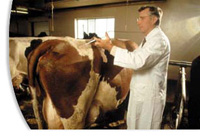Shortfall in veterinarians specializing in livestock could threaten US food safety, study says

The study, commissioned in 2004 by a coalition of veterinary organizations and conducted by Kansas State University's College of Business Administration, projects a major shortfall in the vets by 2016.
The projected shortfall comes as Americans are increasingly aware of bird flu and foot-and-mouth disease, and meat exports have been curtailed by skeptical nations like Japan, which has twice cited concerns over mad cow disease in closing its lucrative market to U.S. beef.
"Not having enough veterinarians in rural communities, out in the field, to do adequate disease surveillance threatens our food security," said Dr. Lyle Vogel, director of the Animal Welfare Division of the American Veterinary Medical Association. "For the first time, this study has scientifically documented there is a shortage and shown the shortage is going to get worse."
The study, released Thursday and the most comprehensive of its kind, found that while demand for food-animal veterinarians is projected to increase 12 to 13 percent over the next decade, four out of every 100 jobs will go unfilled.
The shortfall is also expected to affect government agencies like the U.S. Department of Agriculture's Animal and Plant Health Inspection Service, which is entrusted with protecting U.S. agricultural health.
USDA officials declined to comment without seeing the report. Spokesman Jim Rogers said disease response teams can be on the ground anywhere in the U.S. within four hours, the AP reports.
Donning overalls and rubber boots to deliver calves at all hours of the night is often unappealing to students, who are coming in fewer numbers from rural backgrounds.
Subscribe to Pravda.Ru Telegram channel, Facebook, RSS!





